Antioxidant Activities of Co-Encapsulated Natal Plum (Carissa macrocarpa) Juice Inoculated with Ltp. plantarum 75 in Different Biopolymeric Matrices after In Vitro Digestion
Abstract
:1. Introduction
2. Materials and Methods
2.1. Plant Material and Reagents
2.2. Preparation of Culture
2.3. Development of Natal Plum Juice
2.4. In Vitro Digestion of Natal Plum (Carissa macrocarpa) Juice Extract
2.5. Extraction of Phenolic Compounds in Natal Plum (Carissa macrocarpa) Juice Powder
2.6. Total Phenolic Content (TPC)
2.7. Total Anthocyanin Content (TAC)
2.8. Viability of Lactic Acid Bacteria
2.9. Quantification of Targeted Phenolic Metabolites
2.10. Determination of the Antioxidant Activity of Phenolic Extracts
2.11. Statistical Analysis
3. Results and Discussion
3.1. Encapsulation Efficiency of Ltp. plantarum 75 and Anthocyanin in Natal Plum (Carissa macrocarpa) Juices-Biopolymer Powder
3.2. Effect of Storage Time on the Survival of Ltp. plantarum 75 in Natal Plum (Carissa macrocarpa) Juices
3.3. Effect of In Vitro Digestion on the Survival of Ltp. plantarum 75 from Natal Plum Juices
3.4. Effect of In Vitro Digestion on the Total Phenolic Content (TPC) and Total Anthocyanin Content (TAC) from Natal Plum (Carissa macrocarpa) Juice
3.5. In Vitro Digestibility of Natal Plum (Carissa macrocarpa) Juice Polyphenols
3.6. Effect of In Vitro Gastrointestinal Digestion on the Antioxidant Activities of Natal Plum (Carissa macrocarpa) Juice Phenolic Extract
4. Conclusions
Supplementary Materials
Author Contributions
Funding
Data Availability Statement
Conflicts of Interest
References
- Ndou, A.; Tinyani, P.P.; Slabbert, R.M. Sultanbawa, Y.; Sivakumar, D. An integrated approach for harvesting Natal plum (Carissa macrocarpa) for quality and functional compounds related to maturity stages. Food Chem. 2019, 293, 499–510. [Google Scholar] [CrossRef] [PubMed]
- Seke, F.; Manhivi, V.E.; Shoko, T.; Slabbert, R.M.; Sultanbawa, Y.; Sivakumar, D. Effect of Freeze Drying and Simulated Gastrointestinal Digestion on Phenolic Metabolites and Antioxidant Property of the Natal Plum (Carissa macrocarpa). Foods 2021, 10, 1420. [Google Scholar] [CrossRef] [PubMed]
- Torabian, G.; Valtchev, P.; Adil, Q.; Dehghani, F. Anti-influenza activity of elderberry (Sambucus nigra). J. Funct. Foods 2019, 54, 353–360. [Google Scholar] [CrossRef]
- Scazzocchio, B.; Varì, R.; Filesi, C.; D’Archivio, M.; Santangelo, C.; Giovannini, C.; Masella, R. Cyanidin-3-O-β-glucoside and protocatechuic acid exert insulin-like effects by upregulating PPARγ activity in human omental adipocytes. Diabetes 2011, 60, 2234–2244. [Google Scholar] [CrossRef] [PubMed] [Green Version]
- Cilla, A.; Bosch, L.; Barberá, R.; Alegría, A. Effect of processing on the bioaccessibility of bioactive compounds–A review focusing on carotenoids, minerals, ascorbic acid, tocopherols and polyphenols. J. Food Compos. Anal. 2018, 68, 3–15. [Google Scholar] [CrossRef]
- Bassiri-Jahromi, S. Punica granatum (Pomegranate) activity in health promotion and cancer prevention. Onco. Rev. 2018, 12, 345. [Google Scholar] [CrossRef]
- Sanders, M.E.; Merenstein, D.J.; Reid, G.; Gibson, G.R.; Rastall, R.A. Probiotics and prebiotics in intestinal health and disease: From biology to the clinic. Nat. Rev. Gastro. Hepat. 2019, 16, 605–616. [Google Scholar] [CrossRef]
- Colín-Cruz, M.A.; Pimentel-González, D.J.; Carrillo-Navas, H.; Alvarez-Ramírez, J.; Guadarrama-Lezama, A.Y. Co-encapsulation of bioactive compounds from blackberry juice and probiotic bacteria in biopolymeric matrices. LWT 2019, 110, 94–101. [Google Scholar] [CrossRef]
- Bakowska-Barczak, A.M.; Kolodziejczyk, P.P. Black currant polyphenols: Their storage stability and microencapsulation. Ind. Crops. Prod. 2011, 34, 1301–1309. [Google Scholar] [CrossRef]
- Peng, Z.; Li, J.; Guan, Y.; Zhao, G. Effect of carriers on physicochemical properties, antioxidant activities and biological components of spray-dried purple sweet potato flours. LWT-Food Sci. Techno. 2013, 51, 348–355. [Google Scholar] [CrossRef]
- Kandansamy, K.; Somasundaram, P.D. Microencapsulation of colors by spray drying-a review. Int. J. Food Eng. 2012, 8, 1–15. [Google Scholar] [CrossRef]
- Gandia-Herrero, F.; Jimenez-Atienzar, M.; Cabanes, J.; Garcia-Carmona, F.; Escribano, J. Stabilization of the bioactive pigment of Opuntia fruits through maltodextrin encapsulation. J. Agric. Food Chem. 2010, 58, 10646–10652. [Google Scholar] [CrossRef] [PubMed]
- Marcus, J.B. Chapter 6—Flavor Enhancement Ingredients. In Aging, Nutrition and Taste; Academic Press: Cambridge, MA, USA, 2019; pp. 173–206. [Google Scholar] [CrossRef]
- Fang, Z.; Bhandari, B. Encapsulation of polyphenols—A review. Trends. Food Sci. Technol. 2010, 21, 510–523. [Google Scholar] [CrossRef]
- Esmaeilzadeh, J.; Nazemiyeh, H.; Maghsoodi, M.; Lotfipour, F. Evaluation of the effect of psyllium on the viability of lactobacillus acidophilus in alginate-polyl lysine beads. Advan. Pharma. Bullet. 2016, 6, 337. [Google Scholar] [CrossRef] [PubMed] [Green Version]
- Peredo, A.G.; Beristain, C.I.; Pascual, L.A.; Azuara, E.; Jimenez, M. The effect of prebiotics on the viability of encapsulated probiotic bacteria. LWT 2016, 73, 191–196. [Google Scholar] [CrossRef]
- Nami, Y.; Haghshenas, B.; Yari Khosroushahi, A. Effect of psyllium and gum Arabic biopolymers on the survival rate and storage stability in yogurt of Enterococcus durans IW 3 encapsulated in alginate. Food Sci. Nutr. 2017, 5, 554–563. [Google Scholar] [CrossRef] [Green Version]
- Phromthep, K.; Leenanon, B. Survivability of immobilized Lactobacillus plantarum cells within bacterial cellulose in mamao juice. Int. Food Res. J. 2017, 24, 939–949. [Google Scholar]
- Vanajakshi, V.; Vijayendra, S.V.N.; Varadaraj, M.C.; Venkateswaran, G.; Agrawal, R. Optimization of a probiotic beverage based on Moringa leaves and beetroot. LWT-Food Sci. Technol. 2015, 63, 1268–1273. [Google Scholar] [CrossRef]
- Chen, Y.; Chen, H.; Zhang, W.; Ding, Y.; Zhao, T.; Zhang, M.; Yang, L. Bioaccessibility and biotransformation of anthocyanin monomers following in vitro simulated gastric-intestinal digestion and in vivo metabolism in rats. Food Funct. 2019, 10, 6052–6061. [Google Scholar] [CrossRef]
- Mendes, D.D.C.S.; Asquieri, E.R.; Batista, R.D.; de Morais, C.C.; Ascheri, D.P.R.; de Macêdo, I.Y.L.; de Souza Gil, E. Microencapsulation of jabuticaba extracts (Myrciaria cauliflora): Evaluation of their bioactive and thermal properties in cassava starch biscuits. LWT 2021, 137, 110460. [Google Scholar] [CrossRef]
- Maciel, G.M.; Chaves, K.S.; Grosso, C.R.F.; Gigante, M.L. Microencapsulation of Lactobacillus acidophilus La-5 by spray-drying using sweet whey and skim milk as encapsulating materials. J. Dairy Sci. 2014, 97, 1991–1998. [Google Scholar] [CrossRef] [PubMed] [Green Version]
- Güney, D.; Güngörmüşler, M. Development and comparative evaluation of a novel fermented juice mixture with probiotic strains of lactic acid bacteria and Bifidobact. Probio. Antimicro. Proteins 2021, 13, 495–505. [Google Scholar] [CrossRef] [PubMed]
- Seke, F.; Manhivi, V.E.; Shoko, T.; Slabbert, R.M.; Sultanbawa, Y.; Sivakumar, D. Extraction optimisation, hydrolysis, antioxidant properties and bioaccessibility of phenolic compounds in Natal plum fruit (Carissa macrocarpa). Food Biosci. 2021, 44, 101425. [Google Scholar] [CrossRef]
- Mahdavi, S.A.; Jafari, S.M.; Assadpoor, E.; Dehnad, D. Microencapsulation optimization of natural anthocyanins with maltodextrin, gum Arabic and gelatin. Int. J. Biolog Macromol. 2016, 85, 379–385. [Google Scholar] [CrossRef] [PubMed]
- Pieczykolan, E.; Kurek, M.A. Use of guar gum, gum arabic, pectin, beta-glucan and inulin for microencapsulation of anthocyanins from chokeberry. Int. J. Biolog. Macromol. 2019, 129, 665–671. [Google Scholar] [CrossRef]
- Bosnea, L.A.; Moschakis, T.; Biliaderis, C.G. Complex coacervation as a novel microencapsulation technique to improve viability of probiotics under different stresses. Food Biopro. Technol. 2014, 7, 2767–2781. [Google Scholar] [CrossRef]
- Ding, W.K.; Shah, N.P. Survival of free and microencapsulated probiotic bacteria in orange and apple juices. Int. Food Res. J. 2008, 15, 219–232. Available online: https://www.semanticscholar.org/paper/Survival-of-Free-and-Microencapsulated-Probiotic-in-Juices/9f3a17b70cd235b743dbf039bddb9dc5d757690e (accessed on 6 March 2022).
- Rodrigues, F.J.; Cedran, M.F.; Bicas, J.L.; Sato, H.H. Encapsulated probiotic cells: Relevant techniques, natural sources as encapsulating materials and food applications—A narrative review. Food Res Int. 2020, 137, 109682. [Google Scholar] [CrossRef]
- Huang, S.; Méjean, S.; Rabah, H.; Dolivet, A.; Le Loir, Y.; Chen, X.D.; Schuck, P. Double use of concentrated sweet whey for growth and spray drying of probiotics: Towards maximal viability in pilot scale spray dryer. J. Food Eng. 2017, 196, 11–17. [Google Scholar] [CrossRef]
- Morais, S.G.G.; Borges, G.D.S.C.; Lima, M.D.S.; Martín-Belloso, O.; Magnani, M. Effects of probiotics on the content and bioaccessibility of phenolic compounds in red pitaya pulp. Food Res. Int. 2019, 126, 108681. [Google Scholar] [CrossRef]
- Flores, F.P.; Singh, R.K.; Kerr, W.L.; Phillips, D.R.; Kong, F. In vitro release properties of encapsulated blueberry (Vaccinium ashei) extracts. Food Chem. 2015, 168, 225–232. [Google Scholar] [CrossRef] [PubMed]
- Saikia, S.; Mahnot, N.K.; Mahanta, C.L. Optimisation of phenolic extraction from Averrhoa carambola pomace by response surface methodology and its microencapsulation by spray and freeze drying. Food Chem. 2015, 171, 144–152. [Google Scholar] [CrossRef] [PubMed]
- Mosele, J.I.; Macià, A.; Romero, M.P.; Motilva, M.J. Stability and metabolism of Arbutus unedo bioactive compounds (phenolics and antioxidants) under in vitro digestion and colonic fermentation. Food Chem. 2016, 201, 120–130. [Google Scholar] [CrossRef] [PubMed]
- Ortega, N.; Macià, A.; Romero, M.P.; Reguant, J.; Motilva, M.J. Matrix composition effect on the digestibility of carob flour phenols by an in vitro digestion model. Food Chem. 2011, 124, 65–71. [Google Scholar] [CrossRef]
- Kawabata, K.; Yoshioka, Y.; Terao, J. Role of intestinal microbiota in the bioavailability and physiological functions of dietary polyphenols. Molecules 2019, 24, 370. [Google Scholar] [CrossRef] [Green Version]
- Vallejo, F.; Gil-Izquierdo, A.; Pérez-Vicente, A.; García-Viguera, C. In vitro gastrointestinal digestion study of broccoli inflorescence phenolic compounds, glucosinolates, and vitamin C. J. Agric. Food Chem. 2004, 52, 135–138. [Google Scholar] [CrossRef]
- Peng, M.; Tabashsum, Z.; Anderson, M.; Truong, A.; Houser, A.K.; Padilla, J.; Biswas, D. Effectiveness of probiotics, prebiotics, and prebiotic-like components in common functional foods. Compr. Rev. Food Sci. Food Saf. 2020, 19, 1908–1933. [Google Scholar] [CrossRef]
- Maqsoudlou, A.; Assadpour, E.; Mohebodini, H.; Jafari, S.M. The influence of nanodelivery systems on the antioxidant activity of natural bioactive compounds. Crit. Rev. Food Sci. Nutr. 2020, 62, 3208–3231. [Google Scholar] [CrossRef]
- Wojtunik-Kulesza, K.; Oniszczuk, A.; Oniszczuk, T.; Combrzyński, M.; Nowakowska, D.; Matwijczuk, A. Influence of in vitro digestion on composition, bioaccessibility and antioxidant activity of food polyphenols—A non-systematic review. Nutrients 2020, 12, 1401. [Google Scholar] [CrossRef]
- Manhivi, V.E.; Slabbert, R.M.; Sivakumar, D. Co-Ingestion of Natal Plums (Carissa macrocarpa) and Marula Nuts (Sclerocarya birrea) in a Snack Bar and Its Effect on Phenolic Compounds and Bioactivities. Molecules 2022, 27, 310. [Google Scholar] [CrossRef]
- Rice-Evans, C.A.; Miller, N.J.; Paganga, G. Structure-antioxidant activity relationships of flavonoids and phenolic acids. Free Radic. Biolo. Medic. 1996, 20, 933–956. [Google Scholar] [CrossRef]
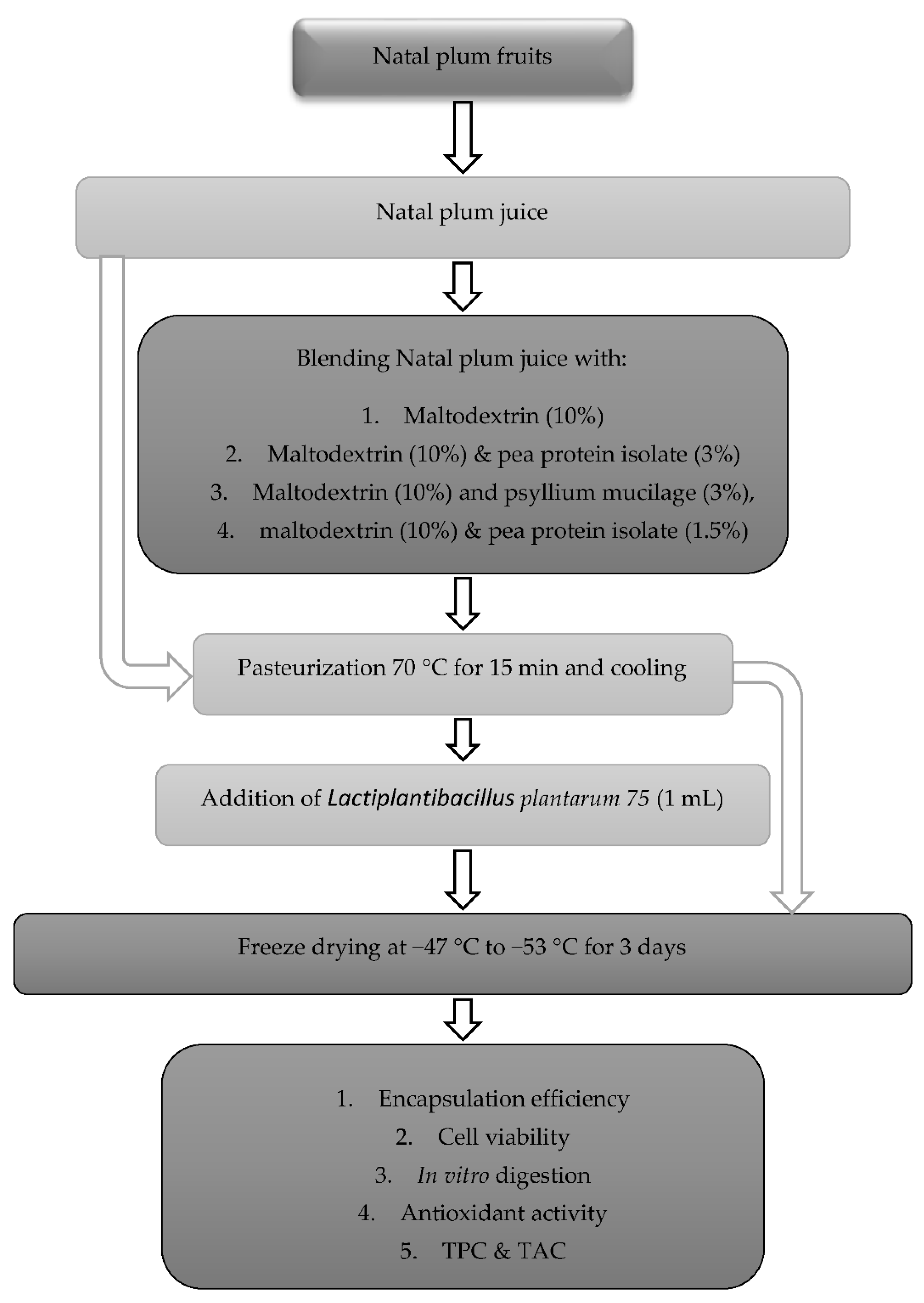
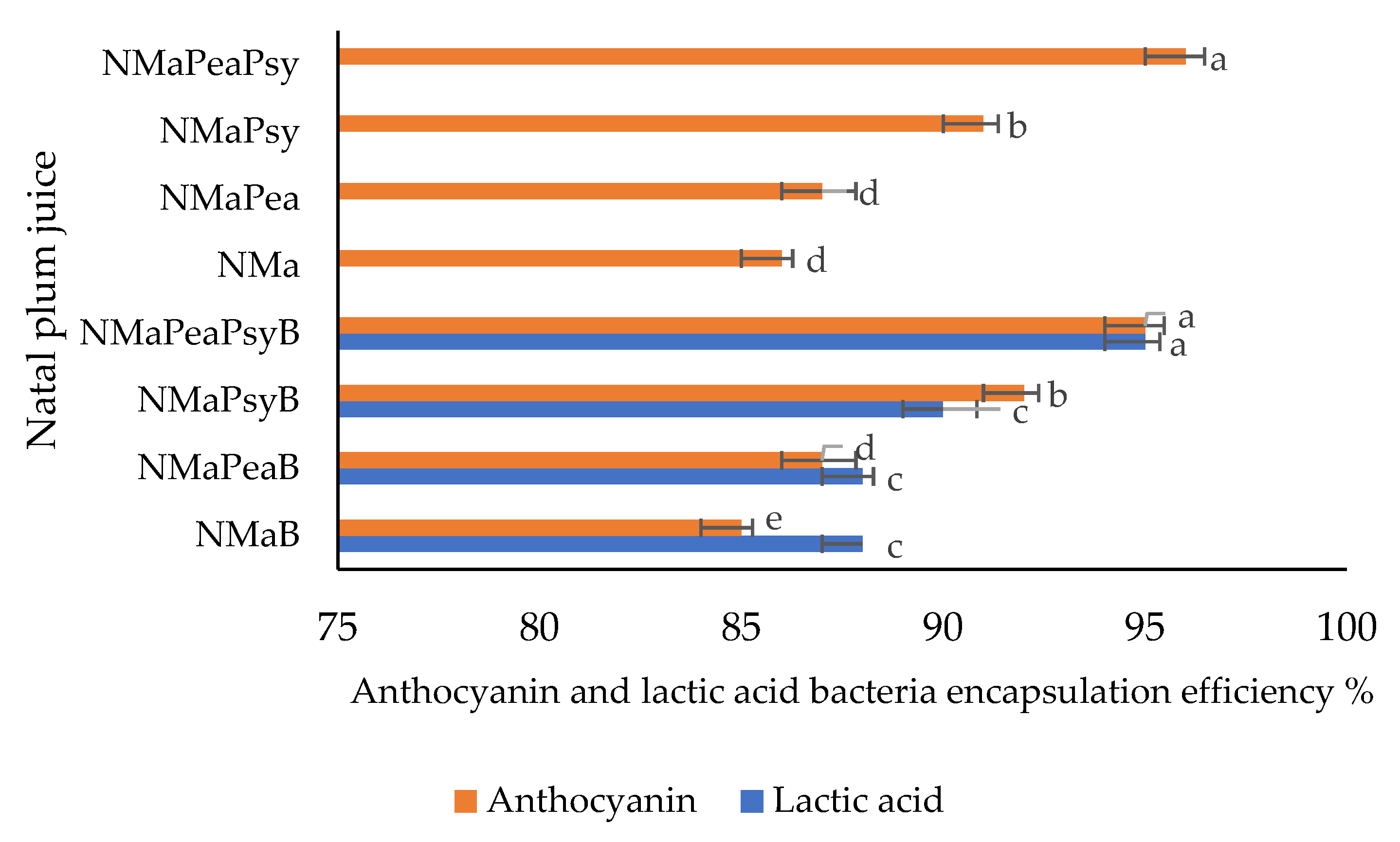
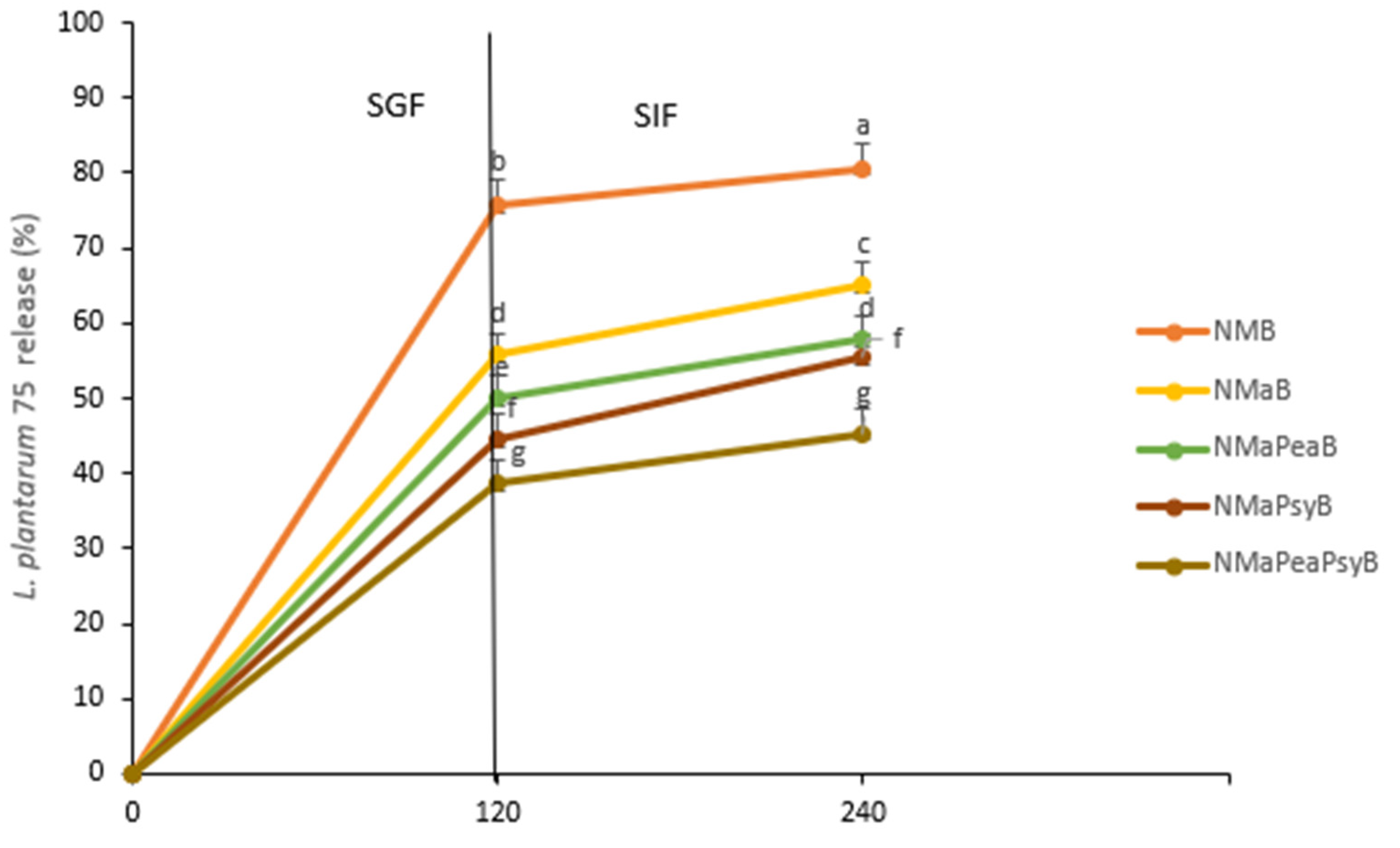
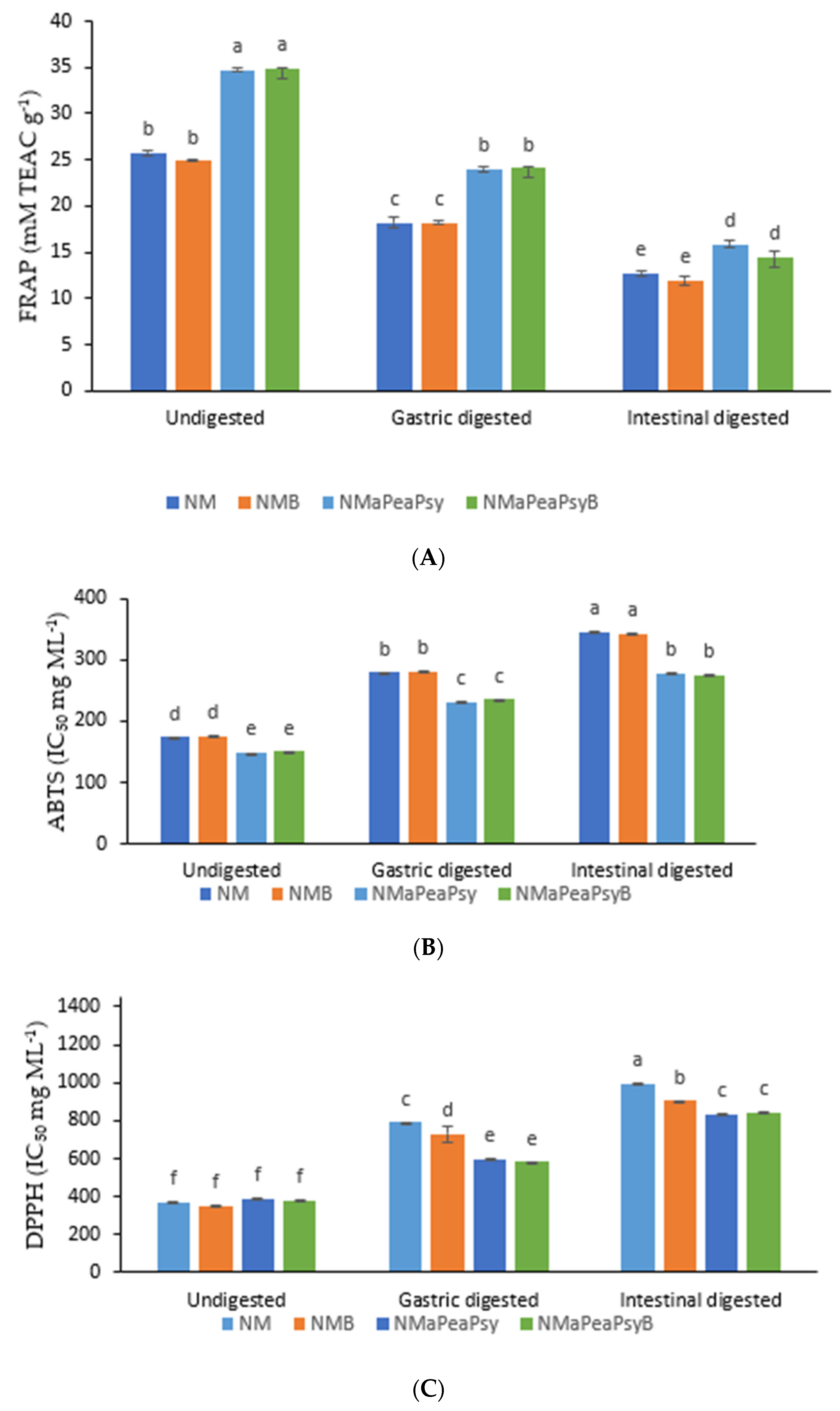
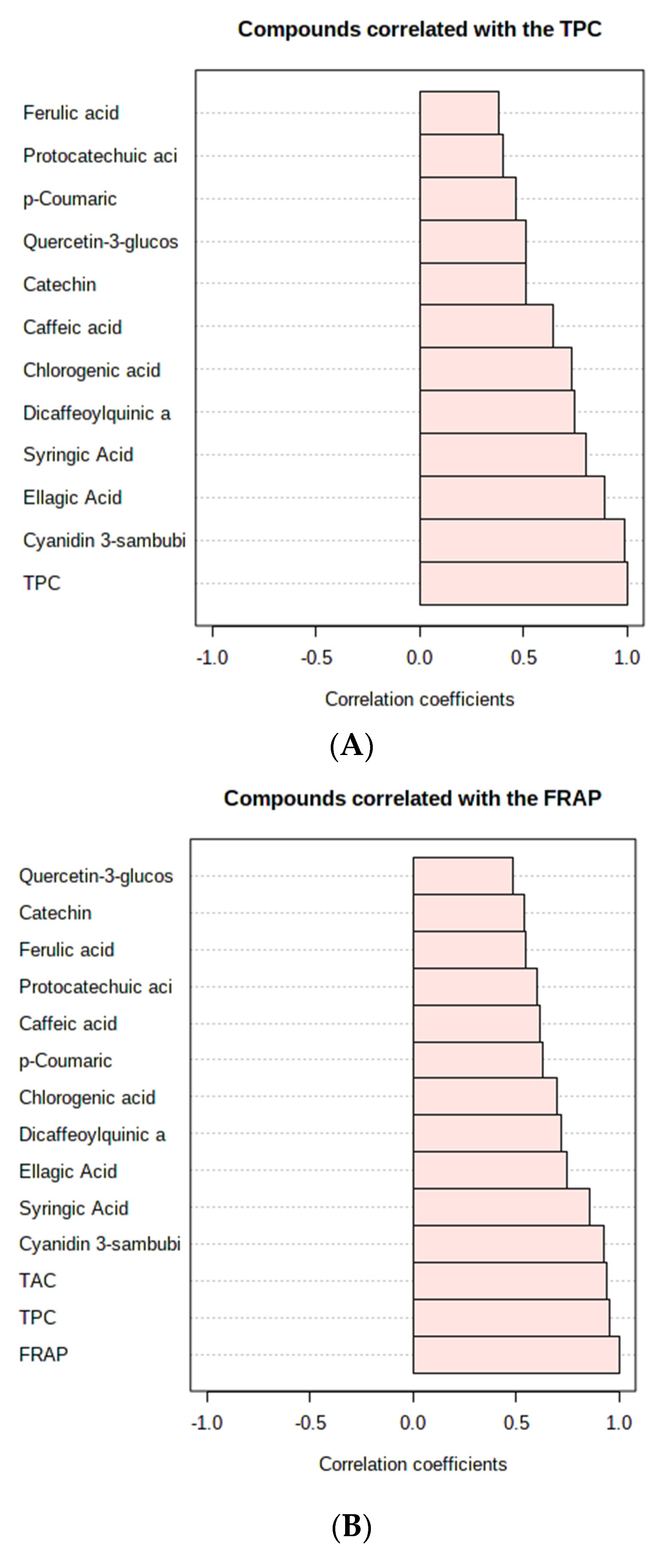
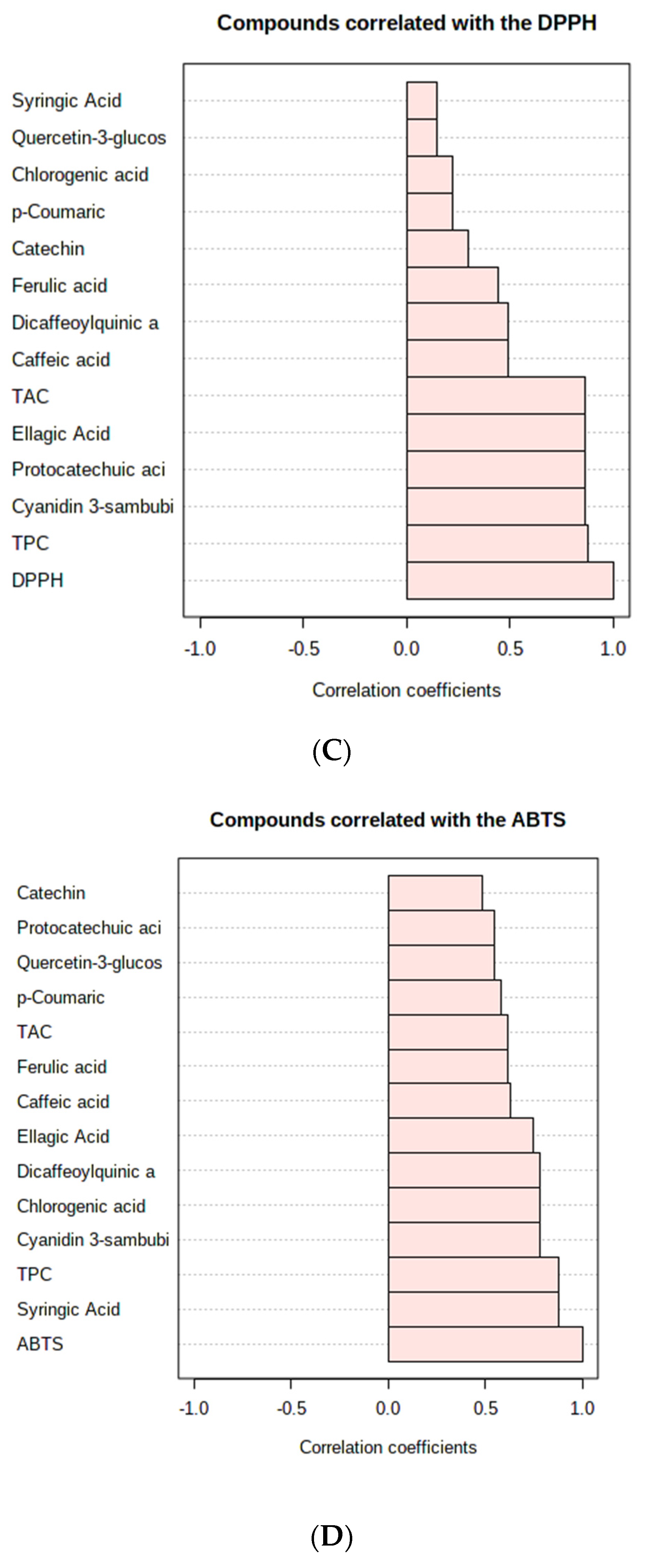
| Sample | Code |
|---|---|
| NM |
| NMB |
| NMa |
| NMaB |
| NMaPea |
| NMaPeaB |
| NMaPsy |
| NMaPsyB |
| NMaPeaPsy |
| NMaPeaPsyB |
| Sample | Day 0 Log CFU mL−1 | Day 7 Log CFU mL−1 | Day 14 Log CFU mL−1 |
|---|---|---|---|
| NMB | 7.25 a ± 0.21 | 4.81 b ± 0.12 (66.34%) | 3.48 c ± 0.78 (48%) |
| NMaB | 7.29 a ± 0.46 | 5.37 b ± 0.82 (73.66%) | 4.08 b ± 0.23 (55.96%) |
| NMaPeaB | 7.79 a ± 0.3 | 5.78 b ± 0.73 (74.19%) | 4.32 b ± 0.69 (55.45%) |
| NMaPsyB | 7.85 a ± 0.83 | 6.12 b ± 0.36 (77.96%) | 5.33 b ± 0.52 (67.89%) |
| NMaPeaPsyB | 8.92 a ± 0.74 | 7.16 b ± 0.87 (80.3%) | 6.74 b ± 0.58 (75.5%) |
| Total Phenolic Content (mg GAE kg−1 DW) | Undigested | Gastric Digested | Intestinal Digested | Bioaccessibility (%) |
|---|---|---|---|---|
| NM | 838.38 a ± 4.89 | 545.36 b ± 2.48 | 310.24 c ± 2.74 | 37.00 d ± 0.47 |
| NMB | 836.53 a ± 2.98 | 555.55 b ± 3.31 | 311.17 c ± 1.29 | 37.19 d ± 1.23 |
| NMa | 840.46 a ± 4.46 | 639.61 b ± 2.19 | 417.47 c ± 2.19 | 49.67 c ± 0.75 |
| NMaB | 840.83 a ± 2.27 | 635.82 b ± 3.13 | 416.73 c ± 1.25 | 49.56 c ± 0.92 |
| NMaPea | 847.19 a ± 5.92 | 675.01 b ± 1.28 | 428.18 c ± 3.93 | 50.00 c ± 0.28 |
| NMaPeaB | 845.69 a ± 4.37 | 671.96 b ± 3.79 | 429.09 c ± 2.20 | 52.60 b ± 0.74 |
| NMaPsy | 847.25 a ± 5.36 | 688.75 b ± 1.75 | 432.71 c ± 3.15 | 50.00 c ± 0.93 |
| NMaPsyB | 845.88 a ± 4.28 | 681.96 b ± 3.38 | 431.39 c ± 2.17 | 52.60 b ± 0.84 |
| NMaPeaPsy | 859.52 a ± 3.76 | 788.63 b ± 2.97 | 472.71 c ± 2.02 | 55.20 a ± 0.83 |
| NMaPeaPsyB | 858.73 a ± 3.82 | 781.06 b ± 1.79 | 473.39 c ± 1.67 | 55.00 a ± 0.96 |
| Total anthocyanin content (mg Cy-Glu 100−1 g DW) | ||||
| NM | 40.27 a ± 0.27 | 39.29 b ± 0.37 | 17.54 c ± 0.28 | 43.55 d ± 0.78 |
| NMB | 40.03 a ± 0.79 | 39.93 b ± 0.53 | 17.38 c ± 0.30 | 43.41 d ± 0.34 |
| NMa | 44.27 a ± 0.34 | 39.23 b ± 0.07 | 24.27 c ± 0.75 | 54.82 c ± 0.88 |
| NMaB | 44.03 a ± 0.53 | 39.46 b ± 0.18 | 23.88 c ± 0.83 | 54.23 c ± 0.34 |
| NMaPea | 45.98 a ± 0.82 | 36.49 b ± 0.35 | 25.29 c ± 0.71 | 55.00 c ± 0.64 |
| NMaPeaB | 45.79 a ± 0.64 | 36.38 b ± 0.72 | 25.09 c ± 0.45 | 54.79 c ± 0.73 |
| NMaPsy | 46.86 a ± 0.84 | 36.02 b ± 0.86 | 27.29 c ± 0.21 | 58.23 b ± 0.58 |
| NMaPsyB | 46.73 a ± 0.37 | 36.78 b ± 0.42 | 26.69 c ± 0.89 | 57.11 b ± 0.39 |
| NMaPeaPsy | 54.32 a ± 0.56 | 36.75 b ± 0.38 | 32.79 c ± 0.41 | 60.36 a ± 0.82 |
| NMaPeaPsyB | 53.23 a ± 0.68 | 36.61 b ± 0.65 | 33.01 c ± 0.23 | 62.00 a ± 0.71 |
| Phenolic Components (mg kg−1) | Undigested | Gastric | Intestinal | Bioaccessibility% |
|---|---|---|---|---|
| NM | ||||
| Cyanidin 3-sambubioside | 467.00 a ± 3.87 | 329.40 b ± 1.00 | 196.54 c ± 2.71 | 42.00 l ± 0.58 |
| Protocatechuic acid | 32.30 a ± 1.03 | 16.01 c ± 0.63 | 19.92 b ± 0.87 | 61.50 f ± 0.62 |
| Chlorogenic acid | 47.99 a ± 0.29 | 22.27 b ± 0.29 | 15.38 c ± 0.83 | 32.10 m ± 0.23 |
| Catechin | 29.10 a ± 1.92 | 10.10 b ± 1.03 | 14.39 c ± 0.44 | 49.50 j ± 0.89 |
| Quercetin-3-glucoside | 53.37 a ± 0.21 | 38.19 b ± 0.82 | 24.01 c ± 0.39 | 44.00 k ± 0.49 |
| Ferulic acid | 27.99 a ± 0.79 | 15.09 c ± 0.22 | 19.28 b ± 0.87 | 68.80 b ± 0.75 |
| Caffeic acid | 25.75 a ± 1.28 | 19.05 b ± 0.68 | 12.65 c ± 0.79 | 49.10 h ± 0.49 |
| p-Coumaric | 28.07 a ± 0.49 | 12.40 b ± 0.65 | 17.28 c ± 0.18 | 61.60 f ± 0.28 |
| Syringic Acid | 15.40 a ± 4.27 | 7.23 b ± 1.80 | 9.47 c ± 1.03 | 61.50 f ± 0.68 |
| Ellagic Acid | 43.35 a ± 0.20 | 27.19 b ± 0.02 | 13.03 c ± 0.87 | 30.10 m ± 0.49 |
| Dicaffeoylquinic acid | 74.45 a ± 0.40 | 47.16 b ± 0.92 | 29.39 c ± 0.22 | 39.47 l ± 0.83 |
| NMB | ||||
| Cyanidin 3-sambubioside | 464.50 a ± 2.79 | 320.02 b ± 1.87 | 185.54 c ± 2.21 | 40.00 l ± 0.61 |
| Protocatechuic acid | 32.98 a ± 0.13 | 16.26 c ± 0.93 | 21.63 b ± 0.55 | 65.58 e ± 0.72 |
| Chlorogenic acid | 46.43 a ± 0.75 | 22.01 b ± 0.03 | 17.89 c ± 0.32 | 38.53 l ± 0.33 |
| Quercetin-3-glucoside | 54.27 a ± 0.38 | 38.39 b ± 0.21 | 22.01 c ± 0.19 | 40.50 l ± 0.58 |
| Catechin | 27.91 a ± 0.84 | 13.10 b ± 0.46 | 15.89 c ± 0.28 | 56.90 h ± 0.70 |
| Ferulic acid | 26.37 a ± 0.21 | 14.49.19 c ± 0.82 | 20.71 b ± 0.39 | 78.54 a ± 0.29 |
| Caffeic acid | 24.19 a ± 1.28 | 18.73 b ± 0.40 | 10.05 c ± 0.91 | 41.50 l ± 0.63 |
| p-Coumaric acid | 27.34 a ± 0.19 | 13.84 b ± 0.25 | 16.09 c ± 0.73 | 58.86 h ± 0.57 |
| Syringic Acid | 14.36 a ± 2.73 | 6.93 b ± 1.04 | 8.52 c ± 1.48 | 59.34 h ± 0.26 |
| Ellagic Acid | 42.73 a ± 0.72 | 25.22 b ± 0.23 | 12.74 c ± 0.59 | 29.80 m ± 0.38 |
| Dicaffeoylquinic acid | 72.28 a ± 0.39 | 47.23 b ± 0.62 | 27.09 c ± 0.53 | 37.47 l ± 0.49 |
| NMaPeapsy | ||||
| Cyanidin 3-sambubioside | 484.00 a ± 4.23 | 459.40 b ± 3.28 | 326.54 C ± 2.76 | 67.50 d ± 0.75 |
| Protocatechuic acid | 46.69 a ± 1.28 | 23.01 c ± 0.63 | 33.92 b ± 0.18 | 72.64 c ± 0.69 |
| Chlorogenic acid | 55.22 a ± 0.21 | 30.48 b ± 0.61 | 35.30 c ± 0.23 | 63.92 f ± 0.15 |
| Catechin | 32.89 a ± 1.03 | 16.10 b ± 0.92 | 20.31 c ± 0.68 | 61.70 f ± 0.49 |
| Ferulic acid | 28.75 a ± 0.13 | 19.09 c ± 0.41 | 24.28 b ± 0.87 | 84.40 a ± 0.51 |
| Caffeic acid | 46.47 a ± 1.70 | 35.04 b ± 0.83 | 27.81 c ± 0.92 | 59.80 g ± 0.27 |
| Quercetin-3-glucoside | 65.27 a ± 0.32 | 49.91 b ± 0.74 | 32.69 c ± 0.15 | 50.00 i ± 0.78 |
| p-Coumaric | 32.56 a ± 1.49 | 16.40 b ± 0.92 | 23.28 c ± 0.72 | 71.48 c ± 0.43 |
| Syringic Acid | 24.28 a ± 2.77 | 19.20 b ± 1.80 | 10.47 c ± 1.03 | 43.10 j ± 0.19 |
| Ellagic Acid | 53.35 a ± 1.20 | 38.19 b ± 0.92 | 28.74 c ± 0.81 | 53.87 h ± 0.95 |
| Dicaffeoylquinic acid | 72.34 a ± 1.44 | 42.84 b ± 1.59 | 39.09 c ± 0.76 | 54.00 h ± 0.70 |
| NMaPeaPsyB | ||||
| Cyanidin 3-sambubioside | 479.00 a ± 3.93 | 454.82 b ± 3.76 | 323.14 c ± 2.02 | 67.50 d ± 0.57 |
| Protocatechuic acid | 44.38 a ± 1.43 | 21.91 c ± 0.78 | 30.39 b ± 0.10 | 68.70 d ± 0.72 |
| Chlorogenic acid | 54.62 a ± 0.72 | 30.37 b ± 0.09 | 34.50 c ± 0.13 | 63.10 f ± 0.69 |
| Quercetin-3-glucoside | 64.87 a ± 0.45 | 49.03 b ± 0.32 | 36.01 c ± 0.90 | 55.50 h ± 0.44 |
| Catechin | 34.27 a ± 0.94 | 15.29 b ± 0.78 | 22.93 c ± 0.60 | 66.90 e ± 0.38 |
| Ferulic acid | 30.50 a ± 0.17 | 18.35 c ± 0.28 | 24.89 b ± 0.81 | 81.60 a ± 0.75 |
| Caffeic acid | 46.74 a ± 0.85 | 37.18 b ± 0.30 | 25.04 c ± 0.19 | 54.00 f ± 0.23 |
| p-Coumaric | 33.05 a ± 0.50 | 18.40 b ± 0.70 | 25.49 c ± 0.30 | 77.10 b ± 0.82 |
| Syringic Acid | 23.65 a ± 2.38 | 20.28 b ± 1.04 | 12.82 c ± 0.84 | 54.20 h ± 0.54 |
| Ellagic Acid | 52.95 a ± 1.74 | 36.90 b ± 0.59 | 30.04 c ± 0.62 | 57.00 h ± 0.93 |
| Dicaffeoylquinic acid | 74.94 a ± 1.12 | 42.04 b ± 0.75 | 37.59 c ± 0.28 | 50.10 i ± 0.47 |
Publisher’s Note: MDPI stays neutral with regard to jurisdictional claims in published maps and institutional affiliations. |
© 2022 by the authors. Licensee MDPI, Basel, Switzerland. This article is an open access article distributed under the terms and conditions of the Creative Commons Attribution (CC BY) license (https://creativecommons.org/licenses/by/4.0/).
Share and Cite
Seke, F.; Manhivi, V.E.; Guerin, M.; Shoko, T.; Akinola, S.A.; Garcia, C.; Remize, F.; Slabbert, R.M.; Sivakumar, D. Antioxidant Activities of Co-Encapsulated Natal Plum (Carissa macrocarpa) Juice Inoculated with Ltp. plantarum 75 in Different Biopolymeric Matrices after In Vitro Digestion. Foods 2022, 11, 2116. https://doi.org/10.3390/foods11142116
Seke F, Manhivi VE, Guerin M, Shoko T, Akinola SA, Garcia C, Remize F, Slabbert RM, Sivakumar D. Antioxidant Activities of Co-Encapsulated Natal Plum (Carissa macrocarpa) Juice Inoculated with Ltp. plantarum 75 in Different Biopolymeric Matrices after In Vitro Digestion. Foods. 2022; 11(14):2116. https://doi.org/10.3390/foods11142116
Chicago/Turabian StyleSeke, Faith, Vimbainashe E. Manhivi, Marie Guerin, Tinotenda Shoko, Stephen A. Akinola, Cyrielle Garcia, Fabienne Remize, Retha M. Slabbert, and Dharini Sivakumar. 2022. "Antioxidant Activities of Co-Encapsulated Natal Plum (Carissa macrocarpa) Juice Inoculated with Ltp. plantarum 75 in Different Biopolymeric Matrices after In Vitro Digestion" Foods 11, no. 14: 2116. https://doi.org/10.3390/foods11142116
APA StyleSeke, F., Manhivi, V. E., Guerin, M., Shoko, T., Akinola, S. A., Garcia, C., Remize, F., Slabbert, R. M., & Sivakumar, D. (2022). Antioxidant Activities of Co-Encapsulated Natal Plum (Carissa macrocarpa) Juice Inoculated with Ltp. plantarum 75 in Different Biopolymeric Matrices after In Vitro Digestion. Foods, 11(14), 2116. https://doi.org/10.3390/foods11142116










